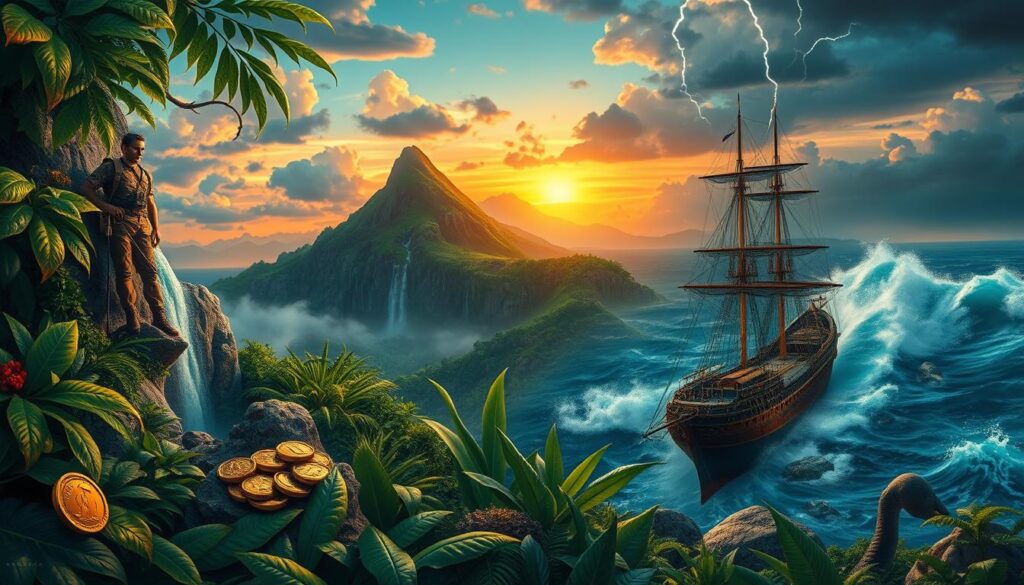Adventure stories are more than just tales of bravery. They are captivating journeys that pull you into a world of thrills and uncertainties. These stories can change your life.
By exploring different types of adventure stories, you can learn more and appreciate this exciting genre. The main types are exploration, survival, and quest adventures. Each offers a unique flavor, taking you to extraordinary places.

Key Takeaways
- Adventure stories are thrilling tales filled with challenges.
- There are three main types: exploration, survival, and quest adventures.
- Exploration adventures are about discovering new places.
- Survival adventures show the fight to survive in tough situations.
- Quest adventures are about a journey to reach a goal.
- Each type has its own themes and lessons for readers.
Introduction to Adventure Stories
Adventure stories are a big deal in storytelling. They grab our attention with exciting plots and characters. These tales take us on thrilling journeys, full of danger and discovery.
From ancient classics like “The Odyssey” to modern hits like “The Hunger Games,” adventure stories connect us all. They share themes of bravery and heroism, touching our hearts and minds.
At the core of adventure tales is a quest. This journey tests the heroes and teaches us about ourselves. As we follow their paths, we feel their triumphs and struggles, making us more invested in the story.
Exploring adventure stories helps us understand their many forms. It opens up a world of adventures that have captivated readers for ages.
Characteristics of Adventure Stories
Adventure stories have unique traits that grab readers’ attention. They often feature dynamic characters facing big challenges. These characters show great determination as they go on thrilling adventures.
Exciting plots are key in these tales. They usually involve a quest or mission. This leads to conflicts with others, nature, or even themselves. The suspense keeps readers eager to find out what happens next.
The stories are filled with vivid images and sensory details. You might find yourself in a dense jungle or a wide ocean. Courage, resilience, and growth are common themes. They make the stories more relatable and meaningful.
Exploring adventure stories shows how they offer unforgettable experiences. The mix of dynamic characters and gripping plots makes each journey exciting. So, get ready to dive into the adventure!
What are Three Types of Adventure Stories?
Adventure stories capture our imagination in many ways. There are exploration, survival, and quest adventures. Each type has its own special elements that make reading exciting.
Exploration Adventures
Exploration adventures are all about the thrill of finding new places. Characters go on journeys to discover new lands and cultures. It’s like you’re exploring jungles or finding hidden treasures right along with them.
Survival Adventures
Survival adventures put characters in tough spots. They face challenges like natural disasters or being alone in the wilderness. These stories show how strong and determined people can be when facing hard times.
Quest Adventures
Quest adventures are about completing a mission. They often deal with themes like finding yourself and making friends. You’ll follow characters on their paths, facing obstacles and growing along the way.
Exploration Adventures Explained
Exploration adventure stories grab our attention with the promise of discovery. They bring us into the thrill of the unknown. These tales often feature adventure features like stunning landscapes, rich cultures, and a deep desire to learn.
Features of Exploration Adventures
Exploration adventures have key traits:
- Detail-rich landscapes that paint a clear picture in our minds.
- Meetings with unknown civilizations, bringing new cultural experiences.
- The quest for knowledge, which can change a person deeply.
Popular Examples of Exploration Stories
In literature examples, “Treasure Island” by Robert Louis Stevenson and “Moby Dick” by Herman Melville are famous. These stories capture the essence of adventure. They inspire us to follow the paths of legendary explorers.

Survival Adventures Unpacked
Survival adventures grab readers with their intense stories. They show how people can endure and adapt. These tales are filled with adventure and highlight the strength of characters.
Elements of Survival Stories
Survival stories have key elements that make them exciting:
- Isolation: Characters are often in remote places, far from people. This makes their survival harder and more tense.
- Resourcefulness: Good characters use what they have to get past challenges.
- Conflict with Nature: Nature is both a foe and a teacher. It tests their survival skills.
- Personal Growth: Characters learn a lot as they face their challenges. They grow stronger and wiser.
- Human Relationships: Friendships or conflicts with others add depth to the story.
Stories like Gary Paulsen’s “Hatchet” show a boy’s fight to survive in the wild. These tales thrill and teach us about resilience and the will to live.
Quest Adventures Defined
Quest adventures are a thrilling part of literature. They follow a hero on a mission to reach a goal. These stories are filled with obstacles that help the characters grow. They also explore important themes that readers find meaningful.
Common Themes in Quest Adventures
Quest adventures often deal with themes that add depth to the story. Some common ones include:
- Friendship: Many tales show how friendships help overcome challenges.
- Loyalty: Characters show strong loyalty to each other, showing its importance.
- Courage: Characters face their fears, teaching us about bravery.
- Good vs. Evil: This theme helps us see the choices characters make.
For instance, “The Lord of the Rings” by J.R.R. Tolkien is a classic quest story. It follows characters on a quest to destroy a bad artifact. The journey is full of challenges that help the characters grow. It also explores the battle between good and evil, making the story both exciting and thought-provoking.

| Theme | Description |
|---|---|
| Friendship | Exploration of deep bonds formed during shared experiences. |
| Loyalty | Commitment between characters drives the quest forward. |
| Courage | Characters face fears, showing growth through adversity. |
| Good vs. Evil | Conflict between benevolent and malevolent forces defines the narrative arc. |
Quest adventures are amazing at mixing themes with character stories. They give us a deep look into human connections and personal growth.
How These Types Impact Readers
Adventure stories deeply touch readers, weaving a rich emotional tapestry. They spark the imagination and create a strong reader connection. Each type—exploration, survival, and quest—offers unique insights into human life. This makes them relatable and inspiring.
Emotional Connections in Adventure Stories
When you read adventure tales, you often feel a strong connection to the characters. Exploration stories spark curiosity, while survival tales show the tough side of life. Quest stories highlight the power of shared experiences. These elements help readers see themselves in the characters’ struggles and victories.
Lessons Learned from Adventure Narratives
Adventure stories hold a wealth of life lessons for us. They teach us about resilience, teamwork, and chasing our dreams. Readers leave not just entertained but also wiser. These stories offer more than just fun; they teach us values for everyday life.
Conclusion
Exploring the three types of adventure stories—exploration, survival, and quest—makes reading more exciting. Each type offers unique insights into human nature and resilience. They also show the thrill of discovery.
These stories not only grab your attention but also make you think about your own experiences and feelings. They help you see the world in a new light.
Adventure stories give you a deeper love for storytelling. Whether you’re exploring new lands, facing survival challenges, or going on a quest, each story takes you on a wild ride of emotions. This shows the wide world of stories waiting for you.
Let these exciting stories inspire your own adventures. Reading them can change how you see your own challenges and journeys. So, pick up a book or watch a movie, and let adventure take you away!
FAQ
What are the different types of adventure stories?
There are three main types of adventure stories. You have exploration, survival, and quest adventures. Each type has its own special elements and themes that grab readers’ attention in unique ways.
How do exploration adventures differ from survival adventures?
Exploration adventures are all about the excitement of finding new things. They often describe beautiful landscapes and cultures in detail. Survival adventures, on the other hand, focus on how characters can survive tough situations. They show how people can overcome nature or tough social situations.
Can you give examples of popular exploration adventure stories?
Sure! “Treasure Island” by Robert Louis Stevenson and “Moby Dick” by Herman Melville are great examples. They take readers on exciting journeys to new places and quests for knowledge.
What themes are commonly found in quest adventures?
Quest adventures often deal with themes like friendship, loyalty, and courage. They also explore the fight between good and evil. These stories show how the main character grows and learns as they face many challenges.
How do adventure stories impact readers emotionally?
Adventure stories connect with readers on a deep level. They tap into our desires for adventure, strength, and friendship. These stories reflect real-life struggles, teaching us about bravery, teamwork, and chasing our dreams.
Are there modern examples of survival adventure stories?
Yes! “Hatchet” by Gary Paulsen is a modern survival adventure story. It tells the tale of a young boy surviving in the wilderness after a plane crash. It shows the power of resilience and the human spirit.




